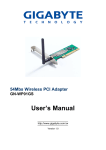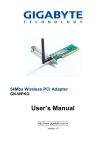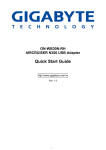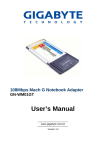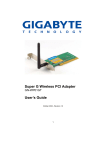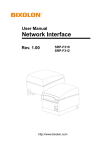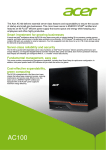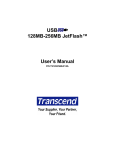Download GIGABYTE GN-WB01GS User's Manual
Transcript
54Mbps Wireless USB Adapter GN-WB01GS User’s Manual http://www.gigabyte.com.tw Rev. 1.0 Federal Communication Commission Interference Statement: This equipment has been tested and found to comply with the limits for a Class B digital device, pursuant to Part 15 of the FCC Rules. These limits are designed to provide reasonable protection against harmful interference in a residential installation. This equipment generates, uses and can radiate radio frequency energy and, if not installed and used in accordance with the instructions, may cause harmful interference to radio communications. However, there is no guarantee that interference will not occur in a particular installation. If this equipment does cause harmful interference to radio or television reception, which can be determined by turning the equipment off and on, the user is encouraged to try to correct the interference by one of the following measures: • Reorient or relocate the receiving antenna. • Increase the separation between the equipment and receiver. • Connect the equipment into an outlet on a circuit different from that to which the receiver is connected. • Consult the dealer or an experienced radio/TV technician for help. FCC Caution: To assure continued compliance, any changes or modifications not expressly approved by the party responsible for compliance could void the user's authority to operate this equipment. This device complies with Part 15 of the FCC Rules. Operation is subject to the following two conditions: (1) This device may not cause harmful interference, and (2) this device must accept any interference received, including interference that may cause undesired operation. IMPORTANT NOTE FCC Radiation Exposure Statement: This equipment complies with FCC radiation exposure limits set forth for an uncontrolled environment. End users must follow the specific operating instructions for satisfying RF exposure compliance. This transmitter must not be co-located or operating in conjunction with any other antenna or transmitter. Contents CHAPTER 1 PRODUCT OVERVIEW...........................................1 1.1 1.2 1.3 1.4 1.5 INTRODUCTION TO THE WB01GS WIRELESS USB ADAPTER .........................................1 FEATURES .................................................................................................................1 PHYSICAL DIMENSIONS & PACKAGING..........................................................................2 LED INDICATORS .......................................................................................................2 SYSTEM REQUIREMENTS ............................................................................................2 CHAPTER 2 INSTALLATION.......................................................3 2-1. INSTALLING THE WB01GS ..........................................................................................3 CHAPTER 3 USING THE WIRELESS UTILITY ...........................8 3.1. 3.2. 3.3. 3.4. 3.5. PROFILE TAB .............................................................................................................8 LINK STATUS TAB .....................................................................................................16 SITE SURVEY TAB ....................................................................................................17 STATISTICS TAB .......................................................................................................18 ABOUT TAB ..............................................................................................................19 APPENDIX A TROUBLESHOOTING.........................................20 APPENDIX B SPECIFICATIONS..................................................21 APPENDIX C REGULATORY INFORMATION ............................22 APPENDIX D WARRANTY ...........................................................23 Chapter 1 Product Overview 1.1 Introduction to the WB01GS Wireless USB Adapter Looking for an easy way to integrate your Desktop or Notebook into your wireless network? You found it with the GIGABYTE WB01GS Wireless USB Adapter. The WB01GS is Plug-and-Play, and connects to any USB-ready PC—just plug it in and you’re ready to share data, printers, or high speed Internet access over your existing wireless network. For Desktop installation, no need to open your PC’s case. Like all USB Plug-and-Play devices, it’s a breeze to setup. Power in a small package Don’t be fooled by its small and convenient size, the GIGABYTE’s WB01GS Wireless USB Adapter is powerful. Enabling 54 Mbps wireless Internet sharing – 5 times faster than most Wireless USB adapters. High-level WEP encryption protects your network from would be hackers without a hit on performance. High-speed USB 2.0 Features a USB 2.0 interface that is up to 40 times faster than USB 1.1 allowing you to realize full 54 Mbps speed of the 802.11g wireless standard. New antenna technology provides superior range above previous-generation 802.11b adapters. The WB01GS supports office roaming for notebook PC users for shared broadband Internet access and resources. GIGABYTE’s Wireless Utility lets you create profiles that reflect specific WLAN settings for each different location or access point you connect to – the coffee shop, University, or at home. So, for powerful Notebook flexibility and wireless convenience, GIGABYTE WB01GS Wireless USB Adapter is what you’re looking for! 1.2 Features Conform to IEEE 802.11b and 802.11g specifications Wireless transmits data rate up to the maximum speed of 54Mbps Dynamically scales the data rate Proprietary Smartsetup 3™ to secure wireless network easily Support 64-bit /128-bit WEP encryption, TKIP, AES, 802.1x, WPA and WPA2 Support Quality of Service WMM Seamless roaming between 802.11b and 802.11g networks 40 faster than USB v1.1 Automatic power management to reduce battery consumption. Driver supports Windows 98SE/Me/2000/XP. 1 1.3 Physical Dimensions & Packaging Dimensions: 77.6 x 31.0 x 9.1mm +/- 0.5mm Before beginning the installation procedures, please inspect the components to assure that they have not been damaged during shipping. The components include: Package Contents • GN-WB01GS Adapter with pocket clip cap • GN-WB01GS Setup CD-ROM • Quick Start Guide In case of any missing or damaged accessories, please contact your local distributor or authorized reseller immediately. If you require returning the damaged product, you must pack it in the original packing material or the warranty will be voided. 1.4 LED Indicators The WB01GS Wireless USB Adapter works with both the USB 1.1 and USB 2.0 interfaces (but USB 2.0 will yield faster data transfer). There are two LED indicators on the Adapter as shown in the diagram below. Link ACT ACT LED Link LED ON WB01GS is transferring data WB01GS has connected to a wireless network OFF No data is transferring Not connected. 1.5 System Requirements For trouble free installation and operation, please assure your PC meets the following minimum system requirements: • • • Notebook or Desktop PC with a Pentium® 300 MHz or higher compatible processor with an available USB 2.0 or 1.1 port. Note: If you do not have a USB 2.0 port on your PC, the throughput of the WB01GS will be limited to the 12 Mbps of the USB 1.1 standard. A CD-ROM drive. 20 Mbytes of free hard disk space. 2 Chapter 2 Installation This chapter covers the installation of the WB01GS Adapter for your Notebook or Desktop PC. The following sections will assist you with proper installation of the Adapter. 2-1. Installing the WB01GS Note: If your system has other third party wireless drivers installed, we suggest you disable them before beginning. You can do this by going to Hardware Manager from Windows Control Panel and click ‘disable’ on the WLAN driver. Step 1: Locate an open USB port on your Notebook or Desktop PC and insert the GN-WB01GS Adapter. Step 2: When the Add New Hardware Wizard screen appears, click Cancel. Figure 2-1. Add New Hardware Wizard Step 3: Insert the GN-WB01GS Installation CD into the CD-ROM drive. The WB01GS Welcome screen will automatically open. 3 Figure 2-2. Welcome screen Step 4: Click Install Wireless LAN Utility to begin installation. Step 6: When the Install Shield welcome screen appears, click Next.. Figure 2-3. Install Shield Step 7: InstallShield will check your operating system and select the appropriate driver. Click Next to proceed. 4 Figure 2-4. Check setup information Step 8: If you receive the message regarding “Windows Logo Testing”, click Continue Anyway. Figure 2-5. Finished installing Step 9: Click Finish to complete installation. 5 2-2. SmartSetup 3 Note: The following section applies to users of GIGABYTE Wireless Routers. GIGABYTE SmartSetup 3 is a powerful, yet user-friendly wireless network configuration wizard specially designed for GIGABYTE wireless networks. If you are connecting to a GIGABYTE wireless router, SmartSetup 3 will detect this and activate. In three easy steps, you can establish a bulletproof WPA wireless network AND configure your Internet connection. Only GIGABYTE delivers this easy, powerful and secure solution for your wireless network! Step 1: Select the GIGABYTE wireless router from the available networks. Figure 2-6. SmartSetup 3 Network Selection Step 2: Create a WPA Passphrase using any keyboard character. Make it no less than 8 but no more than 63 characters in length. Anyone wishing to gain access to your network, will first need to key-in this Passphrase. In the example below, we used ‘I love green eggs and ham’. Figure 2-7. SmartSetup 3 Define Passphrase 6 Step 3: Your GIGABYTE router’s web configuration utility will automatically open, and detect your ISP type. Just key in the Username and Password. Done. Figure 2-8. Auto detecting your ISP type Note: If Figure 12 does not appear, please type 192.168.1.254 in the address bar of your web browser, and click “Smart Setup” from the main menu which displays. For more information about SmartSetup 3, please see the enclosed Quick Start Guide. Congratulations. Your secure WPA wireless LAN and Internet 7 Chapter 3 Using the Wireless Utility The WB01GS Wireless Utility is a powerful application that helps you to configure the Adapter and monitor the statistics of the communication link. It also permits the configuration for parameters while the Adapter is operating – no restarting is required. It also offers more configuration options than does Windows native Zero Wireless Configuration. It appears as the “G” icon in the task bar at the bottom right corner of screen whenever the Adapter is in operation (see Figure 3-1). The quick start icon also doubles as a signal strength monitor, as indicated by its four small green lights. Figure 3-1. WB01GS Wireless Utility quick start icon To open the WB01GS Utility, either double click the quick start icon located in your system tray, or from the Windows Start menu, select Programs, GIGA-BYTE 802.11 WLAN, GN-WB01GS SoftAP and then GN-WB01GS Utility. Note: You may only use the utility to change wireless configurations when the WB01GS Adapter is enabled and operating. You have to use Windows native Zero Configuration tool provided with Windows when the Adapter is not enabled. Opening the WB01GS Wireless Utility, you are presented with the Profile Tab. There are 5 main tabs with which to control and monitor your WB01GS – Profile, Link, Site Survey, Statistics and the About Tab. The following sections will cover each tab in detail. 3.1. Profile Tab The Profile tab shows you the current association information about the profile. (see Figure 3-2). Profiles are useful if you often associate with different access points. You can configure a group of settings depending on the access point you often associate with and save as a profile, Click the Add button to create a new profile (see section below for further details), the Delete button to delete a selected profile, the Edit button to modify a selected profile and click the Activate button to have a selected profile become active. 8 Figure 3-2. Current profile Description of items in Figure 3-2 is as follows: Profile Name: A profile can be saved for various wireless settings in different environments, i.e. home, office, and the corner coffee shop. SSID: The Network Name of the wireless router or Access Point. Channel: Shows the current wireless channel. Authentication: Sever authentication types. They include “OPEN”, “Shared”, “LEAP”, “WPA”, “WPA-PSK”, “WPA2” and “WPA2-PSK”. Encryption: The type of encryption used in this profile: “None”, “WEP”, “AES” and “TKIP”. Network Type: Informs you if an Access Point (infrastructure) or Ad Hoc is connected. In Ad Hoc, you may select a channel for each member participating in Ad Hoc. 3-1-1. Configuration Screen If you want to ADD new profiles, or EDIT existing ones, the Configuration screen will open. Here you will Name your profile, and if you like, select an alternate network type (Ad hoc), restrict on SSID connections and more. All three tabs shown (see Figure 3-3) are related, so when you’re done with all three (Configuration, Authentication, Advanced) tabs, click OK. 9 Figure 3-3. Configuration Description of items in Figure 3-3 is as follows: Profile Name: Users can save different profiles names for different configurations. SSID: Select the AP detected by the system from the drop-down menu or input a SSID. (Default: ANY) Power Saving mode: Select “Power Saving Mode” (PSM) to turn off the Adapter’s transceiver when not in use, or select CAM to continuously turn on transceivers. (Default: OFF) Network Type: “Infrastructure” and “802.11 Ad Hoc”. When Infrastructure network type is chosen, PSM will function but not Preamble. On the contrary, when Ad hoc type is chosen, Preamble will function but not PSM. Also, the Channel option will appear and 802.1X Authentication will be disabled. (Default: Infrastructure) TX Power: Select percentage of transmitted power. (Default: Auto) RTS Threshold: This is a mechanism implemented to prevent the “Hidden Node” problem, “Hidden Node” is a situation in which two stations are within range of the same Access Point, but are not within range of each other. Therefore, they are hidden nodes for each other and can not detect each other. This mechanism is a way to prevent data collision when Adapters require transmission. (Default: OFF) Fragment Threshold: Fragmentation mechanism is used for improving the efficiency when high traffic flows along in the wireless network. (Default: OFF) 3-1-2. Authentication and Security Screen: If an authentication or security setting is configured in your Access Point or router, you must enable this function to ensure successful connection. Use the following tab to configure data security and ID authentication (see Figure 3-4). You may configure 10 different settings in the profile, including 802.11 Protocol Authentication and Security and 802.1X Protocol. Figure 3-4. Authentication and Security Authentication Type: Before a station connects to a SSID, the authentication type used by the SSID must be known. Authentication types include OPEN SYSTEM, WPA, WPA-PSK, WPA2, WPA2-PSK, LEAP and SHARED. Encryption: To prevent unauthorized access to data transmitted on the network, the Adapter and the Access Point agree on a type of data encryption. Any station that wishes to connect must have the same password and encryption scheme to connect. Different authentication types have different level of security. (Default: TKIP) WEP encryption: Select one of the four keys as the default encrypted key. To setup WEP, you will need to set a ASCII or HEX key to connect to Access Point. The WEP Key can only be saved through the setting of profile. 1. Select a Key #. 2. Select a form of the key (Hex or ASCII). 3. Enter password. Please enter 26 hexadecimal digits or 13 ASCII digits. 4. Click OK to save the settings. Making HEX keys: 64-bit - Generated as 10 alphanumeric characters (0-9, a-f) (example: 843c29a562) 128bit - Generated as 26 alphanumeric characters (0-9, a-f) (example: 3c29f2536bef3276d32e364a2c) Note: Using a Hex key is more secure than using an ASCII key, and if you are connecting to a GIGABYTE Router or Access Point, ASCII keys are not allowed and you must use a Hex key. WPA-PSK/WPA2-PSK encryption: WPA-PSK/ WPA2-PSK (Preshared Key) uses TKIP or AES based on your choice. You create a password (or Passphrase as its often called) 11 and the system will use the Passphrase to create a cipher code in which it will encrypt the data. To use WPA-PSK/ WPA2-PSK: 1. Create a Passphrase, and key it in. Use 8~63 ASCII digits. 2. Remember this Passphrase. If you forget the Passphrase, you will have to do a hard reset of the Access Point in order to restore default settings and connect again. 3. Click “OK to save these settings. 3-1-2-1. 802.1X Setting - Certification Tab Clicking Use 802.1X Authentication and then Enter 802.1X configuration from the Authentication and Security Window will bring up the 802.1x Setting Window and the Certification Tab (see Figure 3-5). From the Certification screen, you may configure information about authentication, such as Tunnel Protocol, ID and Password and Client Certificate or Certificate Chain. (see Figure 3-5 and 3-7) Figure 3-5. 802.1X Authentication Description of items in Figure 3-5 is as follows: Authentication type: PEAP, TLS/Smart Card, TTLS and MD5-Challenge. (Default: PEAP) Session Resumption: This feature can create a new connection without the overhead of a full handshake. Identity: The Account’s User ID. Password: Passwords for users accounts can be used when LEAP and MD5-Challenge are selected as authentication types. 12 Use Client Certificate: This certificate is necessary for TLS and an option for PEPA and TTLS. Check “Use Client Certificate” to verify the authenticity of a Client Certificate during the authentication process. Clicking More will open the Client Certificate Selection Window (shown in Figure 3-7). Users can select one suitable certificate as Client Certificate. (Default: OFF) Tunnel Authentication: PEPA and TTLS use two-step authentication method. The first step is that Server sets up a Tunnel with its authentication. No option is need to be set for Client (the PC with the Adapter). The second step is to confirm the validity of Client with assigned authentication type in the Tunnel. Data needed for authentication includes Tunnel ID, Tunnel Password, Client Certificate or Server Authentication. Protocol: Use assigned authentication type in the safe tunnel. Tunnel ID: Users’ accounts. Password: Passwords for users’ accounts. Figure 3-6. Client Certificate Selection List 3-1-2-2. 802.1x Settings - CA Server Tab CA Server is used when TLS, TTLS or PEAP is in use. When Use certificate chain is checked, the Client can verify if such server is reliable and then transmit Client Certificate after the verification is confirmed. 13 Figure 3-7. CA Server Setting To verify the CA server: 1. Confirm if the Server Certificate is issued by assigned certificate issuer. If “Allow Intermediate Authentication” is checked, the server certificate can be issued by one intermediate certificate issuer. 2. Check the server name of server certificate is the same as the name entered by the user or belongs to the same domain. Use certificate chain: If “Use certificate chain” is checked, it indicates that Client will confirm whether CA server is reliable. (Default: OFF) Certificate issuer: CA of a server certificate can be selected from certificate issuers on the drop-down list. (Default: ANY) Allow intermediate Certificates: When this option is checked, the certificate issuer can be an issuer recognized by a specific certificate issuer. On the other hand, the server certificate must be issued by a certificate issuer selected by the user. Server name: This value can be a server name or the name of a domain where the server is located. Server name must match exactly: If this option is selected, the server name of server certificate must be the same as “Server Name” or as the name of domain where the server is located. Domain name must end in specified name: If this option is selected, the certificate issuer must be the domain or secondary domain entered in “Server Name”. 3-1-3. Advanced Screen The Advanced screen is the third tab in the trio of tabs under Edit Profile (see Figure 3-8). 14 It includes the 802.11b/g wireless transmission mode settings. Once you have finished here, just click OK to apply all changes to the Edit Profile and you will return to the Profile Tab (Figure 3-2). A reboot is not needed for changes to take effect. Figure 3-8 Advanced Description of items in Figure 3-8 is as follows: Wireless Mode: Sets infrastructure Protocols, including 802.11 B/G mix and 802.11 B Only. (Default 802.11 B/G mix) Ad Hoc Wireless Mode: Sets Ad Hoc Wireless Protocols, including 802.11 B/G mix, 802.11 B Only and 802.11 G Only. (Default: 802.11 B/G mix) TX Burst: The longest interval between frames is normally one DIFS while frames are transmitted. When this setting is open, the longest interval between frames is one SIFS that means the system is allowed to transmit higher capacity of data in one interval.(Default: OFF) B/G Protection: 802.11b uses CCK modulation. 802.11g uses OFDM while CCK modulation for 802.11b is compatible. To prevent data collision between two stations with 802.11b and 802.11g within range of the same Access Point, it is necessary to set 11B/G Protection. This setting only functions when 802.11 B/G mix is selected as Wireless Mode. Three setting are available: AUTO, ENABLE and DISABLE. This is a mechanism implemented to prevent the “Hidden Node” problem, “Hidden Note” is a situation in which two stations are within range of the same Access Point, but are not within range of each other. Therefore, they are hidden nodes for each other and can not detect each other. This mechanism is a way to prevent data collision when WLAN equipments require transmission. (Default: Auto) TX Rate: This option adjusts settings of TX Rate according to the setting of “Infrastructure Wireless Mode”. (Default: Auto) 15 3.2. Link Status Tab The Link Status tab displays the current association information about the Adapters connection with a wireless network. (see Figure 3-9) Figure 3-9. Link Status Description of items in Figure 3-9 is as follows: Status: Shows current link status. “No Link” will appear on the screen when no connection is available. Otherwise, SSID and BSSID of a link will appear. Channel: The current channel number used by the Adapter. Link Speed: Transmission rate (transferring and receiving) at which data is transferred between Stations with Adapter and AP. The speed will adjust according to different modes (802.11b, 11g or mixed) and distance. Throughput: Displays the transmitting (Tx) and receiving (Rx) bytes per second. Link Quality: Measures quality of the link according to the quality of received AP signal. Signal Strength: Measures signal strength received by RF signal processor and displays the signal strength in dBm. Noise Level: Noise level during connection. 16 3.3. Site Survey Tab The Site Survey tab shows you the list of reachable access points and/or peer-to-peer Stations. Just double click on the SSID that you want to connect or click the Connect button. (see Figure 3-10) Figure 3-10. Site Survey Description of items in Figure 3-10 is as follows: SSID: The name of the wireless network (also known as Network Name). BSSID: Displays the MAC address of the Access Point or router. Signal Strength: Displays the strength of the signal from a station to the AP. Channel: Displays the current channel number used by the Access Point. Encryption: The security method used by the Access Point. Authentication: The authentication type used by the Access Point. Network Type: Informs you if an Access Point (infrastructure) or other stations (802.11 Ad Hoc) is connected. When it is 802.11 Ad Hoc, we can select a channel for all members in 802.11 Ad Hoc. Rescan: Rescan the available networks and then re-display results. Connect: Connects with the highlighted Access Point. Add to Profile: Adds a specific Access Point into the profile. 17 3.4. Statistics Tab The Statistics tab shows you the number of packets sent and received by the Adapter (see Figure 3-11) Figure 3-11. Statistics Description of items in Figure 3-11 is as follows: Frames Transmitted Successfully: Number of frames transmitted successfully. Frames Transmitted Successfully Without Retry: Number of frames transmitted successfully, excluding packets transmitted successfully with more than one retry. Frames Transmitted Successfully After Retry[s]: Number of frames transmitted successfully with more than one retry. Frames Fail To Receive ACK After All Retries: Number of frames failing to receive ACK after many retries. RTS Frames Successfully Receive CTS: Number of RTS frames successfully received CTS (Clear To Send) from AP. RTS Frames Fail To Receive CTS: Number of RTS frames fail to receive CTS from AP. Frames Receive Successfully: Number of frames received successfully. Frames Receive With CRC Error: Number of frames received with CRC Errors. Frames Dropped Due TO Out-of-Resource: Number of frames dropped due to out-of-resource. Duplicate Frames Received: Number of duplicate frames received. Reset Counter: Resets the counter to zero. 18 3.5. About Tab The About tab displays information about current drivers and physical MAC address (see Figure 3-12). Figure 3-12. About Tab GbConfig Version (Date) – The version number (and date) of the Adapter Utility Driver Version (Date) – The version number (and date) of the Adapter Driver. EEPROM Version - Hardware version number of the Adapter’s EPROM. IP Address – The current IP Address of the Adapter. Phy Address – The MAC address of the Adapter. Sub Mask – The current Subnet Mask of the Adapter. Default Gateway – The current IP Address of the Gateway (typically the IP address of the AP). 19 Appendix A Troubleshooting This troubleshooting guide provides answers to some common problems which you may encounter while installing or using GIGABYTE Wireless Adapters. Contact the GIGABYTE Wireless Technical Support Team at www.giga-byte.com if you encounter problems not mentioned in this section. Problem: Cannot connect to an AP Advice: Make sure the SSID for the USB Adapter is the same as the Access Point. Make sure the security settings are the same as that of Access Point. When WEP or WPA encryption is enabled, check if the WEP or WPA keys for the USB Adapter and AP are the same. Make sure if the MAC address of the Adapter is added in the AP Authorization Table. Problem: Can connect to an AP but cannot connect to the Internet Advice: Make sure the security settings are the same as that of Access Point. When WEP or WPA encryption is enabled, check if the WEP or WPA keys for the USB Adapter and AP are the same. Make sure the network configuration (IP address, subnet mask, gateway, and DNS) of your computer are correct. Check the proxy server of the WEB browser is correctly set. Problem: Poor link quality and signal strength Advice: Keep the Adapter away from microwave ovens and large metal objects to avoid radio interference. Keep the distance between the Adapter and the AP as close as possible. Please check www.giga-byte.com for more complete and up to date troubleshooting tips. 20 Appendix B Specifications 1. System Host Interface USB 2.0 Operating Voltages 5V ± 5% Typical Power Transmitting: 330mA, Receiving: 205mA 2. RF Performance 802.11g (backward compatible to 802.11b) Frequency Bands 2412 ~ 2484 MHz (subject to local regulations) Modulation Technology OFDM and DSSS Modulation Techniques 64QAM, 16QAM, QPSK, BPSK, CCK, DQPSK, DBPSK Data Rates 54, 48, 36, 18,12, 9, 11, 6, 5.5, 2, and 1 Mbps, auto fallback Peak Output Power Targeted at 14dBm @54Mbps, 18dBm @11Mbps Minimum Receive Sensitivity Targeted at -70dBm @54Mbps; -85dBm@11Mbps Antenna Printed PCB antenna 3. Safety Regulation and Operating Environment EMC certification FCC Part 15 (USA) CE (Europe) Temperature Range Operating: 0 ~ 40 degree C, Storage: -20 ~ 65 degree C Humidity 10% ~ 85% Non-condensing 4. Software Support Driver Windows 98SE/Me/2000/XP Security 64/128 bit WEP, TKIP, AES, 802.1x, WPA, WPA2 QoS WMM Roaming Seamless roaming among 802.11b/g access points. Management Utility Monitors the network situation. 5. Mechanical Dimensions 77.6 x 31.0 x 9.1mm +/- 0.5mm Weight 15.0 ± 1.0g Packaging Generic, Gigabyte, private labeling optional * Subject to change without notice. 21 Appendix C Regulatory Information CE Mark Warning: This is a Class B product. In a domestic environment, this product may cause radio interference, in which case the user may be required to take adequate measures. FCC Statement: This equipment has been tested and found to comply with the limits for a Class B digital device, pursuant to Part 15 of the FCC Rules. These limits are designed to provide reasonable protection against harmful interference in a residential installation. This equipment generates, uses and can radiate radio frequency energy and, if not installed and used in accordance with the instructions, may cause harmful interference to radio communications. However, there is no guarantee that interference will not occur in a particular installation. If this equipment does cause harmful interference to radio or television reception, which can be determined by turning the equipment off and on, the user is encouraged to try to correct the interference by one of the following measures: Reorient or relocate the receiving antenna. Increase the separation between the equipment and receiver. Connect the equipment into an outlet on a circuit different from that to which the receiver is connected. Consult the dealer or an experienced radio/TV technician for help. FCC Caution: To assure continued compliance, any changes or modifications not expressly approved by the party responsible for compliance could void the user authority to operate this equipment. This device complies with Part 15 of the FCC Rules. Operation is subject to the following two conditions: (1) This device may not cause harmful interference, and (2) this device must accept any interference received, including interference that may cause undesired operation. IMPORTANT NOTE: FCC Radiation Exposure Statement: This equipment complies with FCC radiation exposure limits set forth for an uncontrolled environment. This equipment should be installed and operated with minimum distance 20cm between the radiator & your body. The antenna(s) used for this transmitter must not be co-located or operating in conjunction with any other antenna or transmitter. Europe - Declaration of Conformity This device is a 2.4 GHz low power RF device intended for home and office use in EU and EFTA member states. In some EU / EFTA member states some restrictions may apply. Please contact local spectrum management authorities for further details before putting this device into operation. GIGA-BYTE Technology, Inc. declares that the product: Wireless Broadband Router Model Number: GN-B49G is in conformity with and in accordance with the European Directive of EMC, 89/336 EEC for the following sections: EN 61000-3-2, EN 61000-3-3, EN 55024, and EN 55022 Disturbances and Immunities GIGA-BYTE Technology, Inc. also declares the conformity of above mentioned product with the actual required safety standards in accordance with LVD Directive 73/23 EEC: EN 60950 Safety In accordance with R&TTE Directive 1995/5/EC, Part 17: Requirements for Operation in the European Community, GIGA-BYTE Technology, Inc declares the conformity of the above mentioned products for: EN 300 328-2 V1.2.1, ETSI EN 300 328-1:V1.3.1, EN 301 489-1, and EN 301 489-17 Technical Requirements for Radio Equipment Countries of Operation and Conditions of Use in the European Community The user should run the configuration utility program provided with this product to check the current channel of operation and confirm that the device is operating in conformance with the spectrum usage rules for European Community countries as described in this section. European standards dictate a maximum radiated transmit power of 100mW EIRP and a frequency range of 2.400 - 2.4835 Ghz. Operation using 2.4 GHz Channels in France 2.4 GHz Bande: les canaux 10, 11, 12, 13 (2457, 2462, 2467, et 2472 MHz respectivement) sont complétement libres d'utilisation en France (en utilisation intérieur). Pour ce qui est des autres canaux, ils peuvent être soumis à autorisation selon le départment. L'utilisation en extérieur est soumis à autorisation préalable et très restreint. Vous pouvez contacter l'Autorité de Régulation des Télécommunications (http://www.art-telecom.fr) pour de plus amples renseignements. Please check ART's web site for latest requirements for use of the 2.4GHz band in France: http://www.art-telecom.fr/eng/index.htm. When operating in France, this device may be operated under the following conditions: Indoors only, using any channel in the 2.4465-2.4835 GHz band. Trademarks: GIGABYTE is a registered trademark of GIGA-BYTE Technology, Inc. Other trademarks or registered trademarks are the property of their respective manufacturers or owners. Copyright Statement: No part of this publication or documentation accompanying this Product may be reproduced in any form or by any means or used to make any derivative such as translation, transformation, or adaptation without permission from GIGABYTE/GIGA-BYTE Technology, Inc., as stipulated by the United States Copyright Act of 1976. Contents are subject to change without prior notice. Copyright© 2004 by GIGA-BYTE Technology, Inc. All rights reserved. 22 Appendix D Warranty Limited Warranty Statement (1-Year Warranty) Thank you for purchasing the GIGABYTE Product. This limited warranty statement will provide you one year warranty starting from the purchase date. Of which if any defect is occurred due to accidents or any man-made factors, or any unauthorized torn-off or damage to GIGABYTE’s sticker on the product, GIGABYTE Technology will not provide after-sale services, such as: • • • • • • • • Products are damaged due to any violation of instructions on user manual. Hardware is damaged due to inappropriate assembling. Products are damaged due to the use of illegal accessory. Products are damaged due to parts disassembling without authorization. Products are damaged due to exceeding environment limits. Products are damaged due to unexpected external force. Products are damaged due to nature disasters. Products are copies or illegally smuggled goods. PLEASE RECORD THE FOLLOWING INFORMATION REGARDING YOUR WARRANTY Name of Customer: Phone No: Address: Email: Model: Serial: Date of Purchase: Place of Purchase: From Whom: Distributor: Customer Service GIGA-BYTE TECHNOLOGY CO., LTD. No.6, Bau Chiang Road, Hsin-Tien, Taipei Hsien, Taiwan. Tel: 886-2-8665-2665 Fax:886-2-8912-4007 http://www.gigabyte.com.tw 23


























